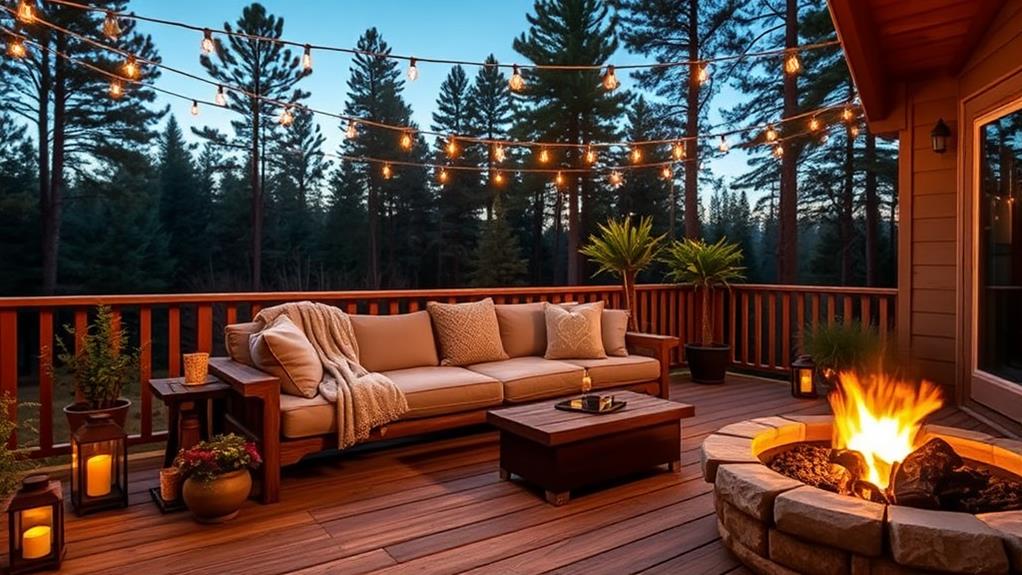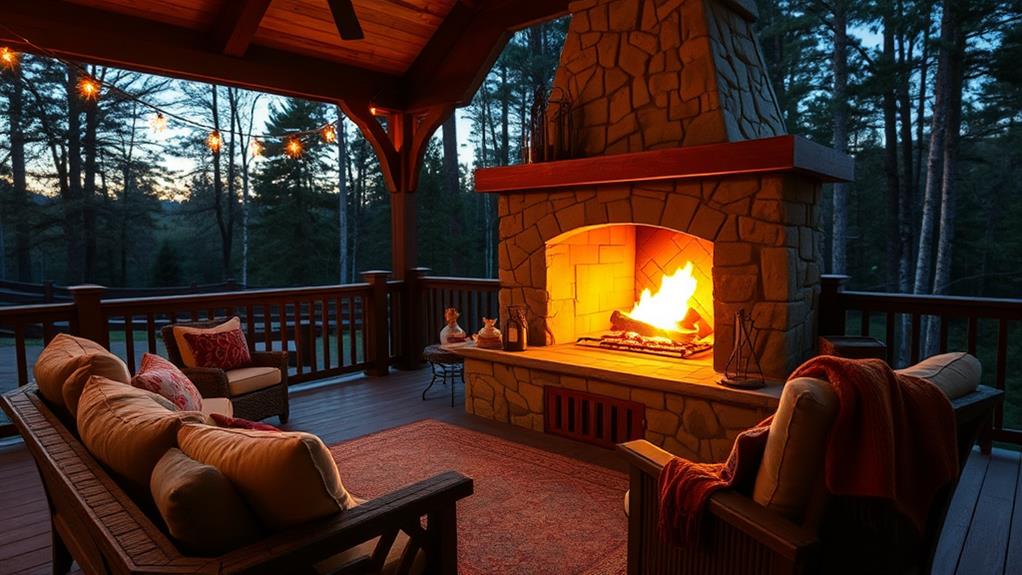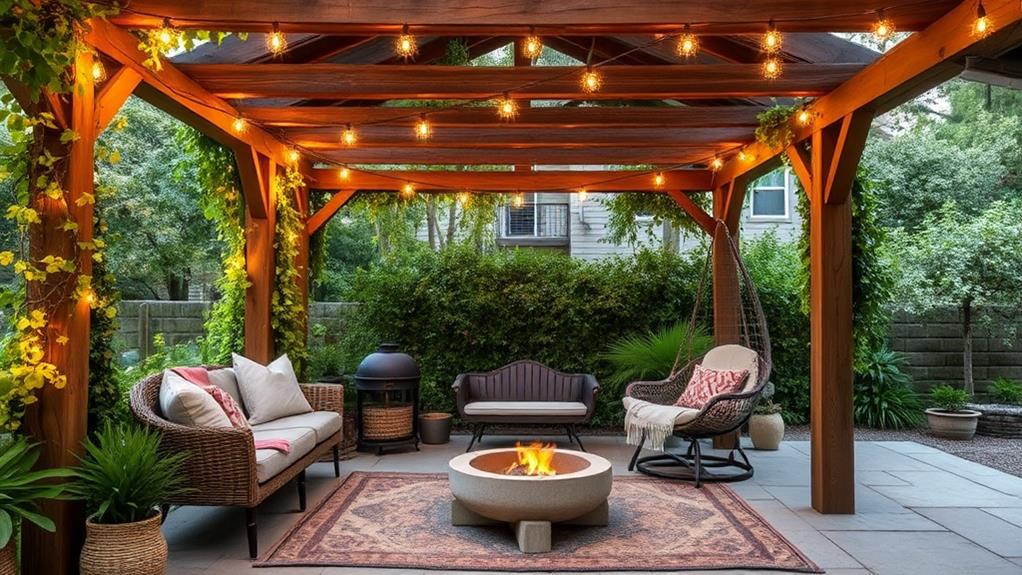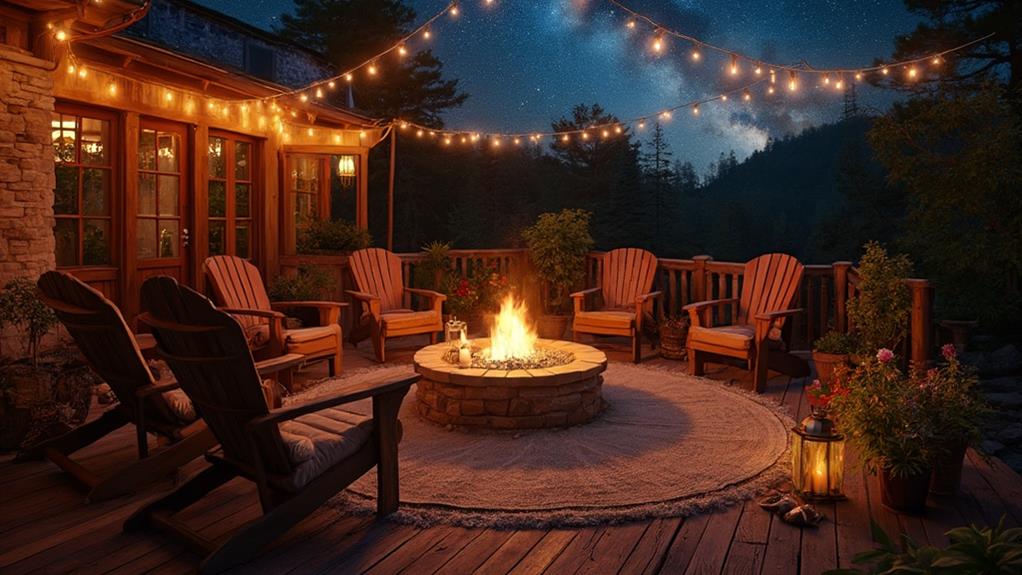Bringing hygge outdoors involves creating a cozy and inviting atmosphere in your backyard. Start by designing a comfortable seating area with plush cushions and soft textiles. Incorporate warm lighting through string lights, lanterns, and fire features to create a magical ambiance. Use natural elements like wood and stone to add texture and warmth. Install an outdoor fireplace or fire pit as a focal point for gatherings. Don't forget to add sensory elements with fragrant plants and soothing water features. Create a sheltered nook for intimate conversations and relaxation. These ideas will help transform your outdoor space into a hygge haven that beckons you to linger and unwind.
Create a Cozy Seating Area

To truly transform your outdoor space into a comfortable retreat, creating a cozy seating area is essential. Start by selecting weather-resistant furniture that prioritizes comfort and durability. Opt for deep-seated sofas or oversized chairs with plush cushions to encourage relaxation. Incorporate a mix of textures through throw pillows and blankets, which not only add visual interest but also provide warmth on cooler evenings.
Arrange the seating in a conversational layout, fostering intimacy and encouraging interaction. Consider adding a focal point, such as a fire pit or outdoor fireplace, to anchor the space and provide warmth and ambiance. For added coziness, install outdoor lighting options like string lights, lanterns, or strategically placed spotlights to create a warm glow as the sun sets.
To enhance comfort underfoot, lay down an outdoor rug that complements your decor while defining the seating area. Finally, incorporate natural elements like potted plants or vertical gardens to soften the space and connect it with the surrounding landscape. By thoughtfully combining these elements, you can create an inviting outdoor sanctuary that beckons family and friends to gather and unwind.
Illuminate With Warm Lighting
When designing a cozy outdoor living space, proper lighting plays a crucial role in creating the right ambiance. Warm lighting can transform your outdoor area into an inviting sanctuary, perfect for relaxation and entertaining. Opt for soft, golden-hued lights that mimic the glow of candlelight to achieve a hygge-inspired atmosphere.
Consider installing dimmable LED string lights or fairy lights along fences, pergolas, or tree branches to create a magical canopy effect. Solar-powered lanterns or mason jar lights can be strategically placed on tables or hung from shepherd's hooks for a charming touch. For a more permanent solution, invest in low-voltage landscape lighting to illuminate pathways and highlight key features of your outdoor space.
Incorporate various light sources at different heights to add depth and interest. Use wall sconces, pendant lights, or even a chandelier in covered areas to bring indoor comfort outside. Don't forget about the practicality of task lighting near grilling or dining areas. Finally, embrace the natural flicker of flame with outdoor fireplaces, fire pits, or tabletop candles to complete the cozy ambiance of your outdoor living space.
Incorporate Natural Elements

By incorporating natural elements into your outdoor living space, you can create a harmonious connection with the surrounding environment. Natural materials like wood, stone, and plants not only enhance the aesthetic appeal but also contribute to a calming atmosphere. Consider installing wooden decking or pergolas to add warmth and texture. Stone pathways or retaining walls can provide a rustic charm while blending seamlessly with the landscape.
Integrate lush greenery through strategically placed potted plants, vertical gardens, or raised flower beds. Native plants are particularly beneficial as they require less maintenance and support local ecosystems. Water features like fountains or small ponds can introduce a soothing auditory element and attract wildlife. For seating areas, opt for furniture made from natural materials such as teak, rattan, or bamboo. Complement these with organic textiles like cotton or wool for cushions and throws.
Incorporate natural scents by planting aromatic herbs or flowers near seating areas. Lavender, rosemary, and jasmine are excellent choices for their calming fragrances. Finally, use natural screening elements like bamboo or reed fencing to create privacy while maintaining an organic feel in your outdoor space.
Add Soft Textiles and Textures
Numerous soft textiles and textures can transform your outdoor living space into a cozy retreat reminiscent of indoor comfort. Begin by layering plush outdoor rugs to define seating areas and add warmth underfoot. Choose weather-resistant materials like polypropylene or recycled plastic for durability and easy maintenance.
Incorporate throw pillows in various sizes, shapes, and textures to create inviting seating arrangements. Opt for fade-resistant fabrics such as Sunbrella or solution-dyed acrylic to withstand sun exposure and occasional rain.
Add cozy throws or blankets for chilly evenings, selecting materials like outdoor fleece or water-repellent wool blends.
Consider installing outdoor curtains or drapes to create a sense of enclosure and privacy. These can also provide shade and protection from wind. Choose lightweight, quick-drying fabrics like polyester or acrylic blends.
For additional texture, introduce woven elements such as rattan or wicker furniture, complemented by soft cushions. Hanging chair swings or hammocks with plush padding offer both comfort and a touch of whimsy. Finally, don't forget to include soft lighting options like string lights or lanterns to enhance the cozy ambiance after dark.
Design an Outdoor Fireplace

The allure of an outdoor fireplace can transform any backyard into a cozy year-round retreat. When designing an outdoor fireplace, consider both aesthetics and functionality.
Choose materials that complement your home's exterior and existing landscape, such as natural stone, brick, or stucco. Determine the optimal location, ensuring proper ventilation and safety clearances from structures and vegetation.
Decide between wood-burning and gas-powered options, each offering unique benefits. Wood-burning fireplaces provide an authentic ambiance and crackling sounds, while gas models offer convenience and cleaner operation.
Incorporate seating areas around the fireplace to create an inviting gathering space. Built-in benches or a semicircle of weather-resistant chairs can encourage conversation and relaxation.
Add practical features like a raised hearth for
Cultivate a Sensory Garden
Moving from the warmth of an outdoor fireplace to the multisensory experience of a garden, cultivating a sensory garden offers a unique way to enhance your outdoor living space. This type of garden engages all five senses, creating a immersive and relaxing environment.
For sight, incorporate a variety of colors, textures, and shapes through diverse plant selection. Choose flowers with vibrant hues and interesting foliage patterns. To stimulate touch, include plants with different textures, such as soft lamb's ear or rough bark. Aromatic herbs like lavender, rosemary, and mint provide pleasant scents, while ornamental grasses offer soothing rustling sounds as they sway in the breeze.
Consider adding a water feature for both auditory and visual appeal. Edible plants like strawberries or cherry tomatoes can satisfy taste. Arrange your garden with winding paths and secluded seating areas to encourage exploration and relaxation. Use raised beds or vertical gardening techniques to make plants more accessible for touching and smelling.
Incorporate natural materials like stone, wood, and gravel to enhance the sensory experience underfoot. By carefully selecting and arranging elements that stimulate all senses, you can create a cozy, engaging outdoor retreat that promotes mindfulness and connection with nature.
Build a Sheltered Nook

Creating a sheltered nook in your outdoor space provides a cozy retreat for relaxation and quiet contemplation. To build this secluded haven, start by selecting a suitable location that offers some natural protection from the elements, such as against a wall or in a corner of your garden.
Consider installing a pergola or gazebo structure to provide overhead shelter. These can be customized with retractable fabric canopies or climbing plants for added shade and privacy. Alternatively, a simple lean-to roof attached to an existing wall can create an effective sheltered area.
Furnish your nook with comfortable, weather-resistant seating options like a bench, swing, or oversized chair. Add plush cushions and throw blankets for extra coziness. Incorporate lighting elements such as string lights, lanterns, or solar-powered fixtures to extend the usability of your nook into the evening hours.
To enhance the sense of enclosure, use natural screens like bamboo or create living walls with vertical gardens. These not only provide privacy but also contribute to a serene atmosphere. Finally, personalize your sheltered nook with decorative elements that reflect your style and create a warm, inviting ambiance.
Frequently Asked Questions
How Can I Maintain Hygge Elements During Extreme Weather Conditions?
To maintain hygge elements during extreme weather, focus on creating protected spaces with weatherproof materials, incorporating portable heating or cooling solutions, and using durable, all-season textiles. Ensure proper insulation and lighting to maintain a cozy atmosphere regardless of conditions.
What Are Budget-Friendly Alternatives for Creating a Hygge Outdoor Space?
As luck would have it, creating a budget-friendly hygge outdoor space is entirely achievable. Consider repurposing indoor items, utilizing thrift store finds, incorporating DIY projects, and focusing on soft lighting and cozy textiles to cultivate a warm, inviting atmosphere.
How Do I Blend Hygge Elements With Existing Modern Outdoor Designs?
To blend hygge elements with modern outdoor designs, incorporate soft textiles, warm lighting, and natural materials. Add cozy seating areas, use muted colors, and introduce rustic accents. Balance minimalism with comfort to create a harmonious, inviting atmosphere.
Are There Specific Plants That Enhance the Hygge Atmosphere Outdoors?
Picture a Scandinavian forest: Evergreens like pine and spruce create a cozy atmosphere outdoors. Lavender, with its soothing scent, enhances relaxation. Soft-textured plants such as lamb's ear and ornamental grasses add tactile comfort to your hygge-inspired outdoor space.
Can Hygge Principles Be Applied to Small Balconies or Limited Outdoor Spaces?
Absolutely! Hygge principles can be effectively applied to small balconies and limited outdoor spaces. Utilize cozy seating, soft lighting, warm textiles, and potted plants to create an intimate, comfortable atmosphere that maximizes the available area for relaxation and enjoyment.
Conclusion
As the hygge movement extends beyond Scandinavian interiors, outdoor spaces transform into whimsical cocoons of comfort. Picture a garden gnome, traditionally stoic, now lounging on plush pillows by a roaring fire pit, sipping hot cocoa beneath twinkling fairy lights. This satirical image encapsulates the essence of outdoor hygge: a fusion of coziness and nature. By reimagining exterior environments with warmth and texture, homeowners create sanctuaries that blur the lines between indoor luxury and outdoor serenity.

